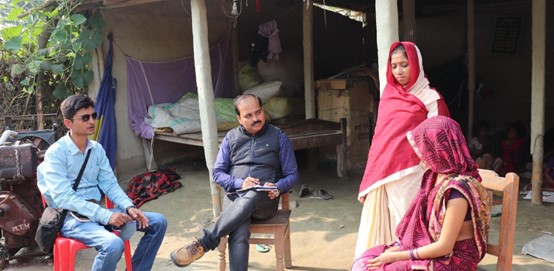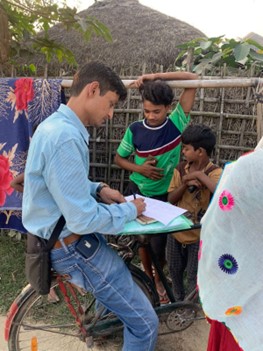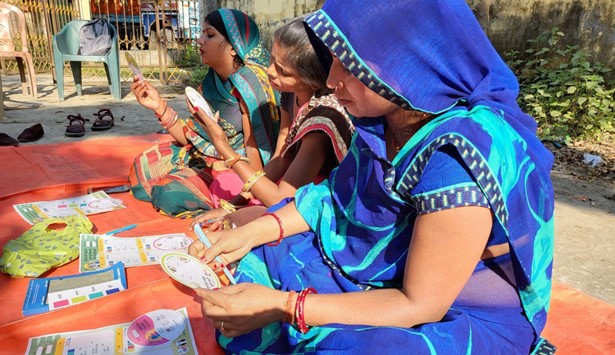Notification: PCI India has successfully migrated from pciglobal.org to pciglobal.in. All emails received from our new domain pciglobal.in are to be treated as undisputed origin.
- About Us
- Our Work
- Health and Nutrition
- Gender, DEI and Social Norms
- Women Economic Empowerment and Livelihoods
- Social and Environment Protection
- Emergency Response
- Skilling & Employability
- Our Expertise
- PCI Research
- Events
- Resources
- Get Involved
- About Us
- Our Work
- Health and Nutrition
- Gender, DEI and Social Norms
- Women Economic Empowerment and Livelihoods
- Social and Environment Protection
- Emergency Response
- Skilling & Employability
- Our Expertise
- PCI Research
- Events
- Resources
- Get Involved
The road to achieving complete vaccination coverage in Bihar continues to be a challenge. While the government has been working rigorously towards 100% coverage, pushing vaccination safety, closing in on the supply gaps that existed earlier and reiterating the value of two dose uptake; there is a need to separately look at special groups and vulnerable populations that are slipping through the cracks.
The Packard Foundation supported RECOVER project, an embedded partnership between Project Concern International (PCI) and the Vihara Innovation Team, is actively supporting the Government of Bihar’s endeavour to achieve 100% vaccination coverage.
- Addressing fears around Infertility and Miscarriage: Owing to media exposure, access to Whatsapp and the low literacy rates, especially in the Scheduled Caste and Muslim Minority communities, misinformation that vaccination leads to infertility has been widely consumed and spread. A large number of men and women in their early reproductive years fear they might become sterile or infertile. While one of the motivations for vaccination uptake within men in these impoverished communities has been finding work outside, the fear of infertility is so strong that the women have not been permitted to take the vaccination. Additionally, when it comes to the groups most reluctant or ambivalent, pregnant & lactating women are concerned about the safety of their child. One of the major barriers for this has been that initially vaccination was heavily advertised as being unsafe for the health of the mother and the child. However, once this instructional mandate was updated, there wasn’t enough promotional campaigning done to convince the public otherwise.
- Bridging the information gap: While looking at the ongoing vaccination camps and getting a sense of the mobilisation process on the field, what surfaced was a rampant discrepancy in the information meted out to the beneficiaries. Whether it’s the ASHA, ANM or any supply side officer – the information shared by each of the above regarding who can take the vaccination, when, how and what precautions to take before and after the process varied widely. Two major reasons for this: first, lack of job-aid for the officials, especially the Front Line Workers (FLWs) due to a dearth in timeline, financial and personnel resources. And secondly, in order to handle the huge responsibility of their peers some FLWs resort to making their own rules to safeguard their position in the community.
- Building the broken trust: Due to lack of tools around counselling and mobilizing, there has been less time for training the mobilizers around various approaches that can help with the vaccination process. Currently, the counselling tactics employed are based on misinformation dissemination such as ‘no-side effects after vaccination, nothing happens’. The preparation required before a medical procedure like vaccination has lost its importance in the state of mass vaccination, making it crucial to educate people on what the process is like. On the field, the tone as well is questioning the beneficiary rather than lending an empathetic ear. In addition, especially within the Muslim minority community, there is already a breach of trust for the system in lieu of the socio-political milieu in the country.
- Identifying the special groups and post-vaccination follow-ups While the CoWIN portal has smoothened the data collection input and updation process, there is no systematic approach at the mobilization level to track and identify special groups. As a dominant form of reluctance towards vaccination comes from the fear of Adverse Event Following Immunization (AEFI), there is no process that encourages tracking and follow-up of those vaccinated, especially vulnerable populations such as pregnant women, elderly, and those with chronic illness.
ON THE FIELD
- Recruiting the Village Mobilization Coordinator:

To encourage trust building and reach the unreachable and reluctant pockets, a Village Mobilization Coordinator (VMC) is being recruited in every village.
This people-centered approach considers:- 1 VMC for a village with 1000-1200 households and 2 VMCs for a village with 1700-1800 plus households.
- The VMC will be identified for the communities that have lowest vaccination coverage. This will not just help understand the layered reasons for hesitancy but also establish a trusted source and on-ground link with the communities.
- The VMC will be a woman, as our situational analysis suggests majority women in rural Bihar are uncomfortable conversing with men and also consider it culturally inappropriate.
- Mostly, we are looking at hiring the Community Mobilizers through the Jeevika program. Our research suggests that the Jeevika SHGs have a wide-spread reach in the most remote rural Bihar areas. Additionally, there is an additional layer of trust built due to the financial inclusion role that Jeevika plays.
- Under RECOVER the VMCs have 4 main tasks:
- House-to-house survey
- Strategic Counselling
- Reminders before camps
- Follow-up post vaccination to check-in and offer reassurance
- Undertaking Line-listing:
 Under RECOVER Bihar Project, the plan is to identify (18+) beneficiaries remaining to be vaccinated and streamlining the process to categorise them into special groups and any form refusal plus note their recent health history in terms of COVID. The line listing is to be undertaken by the respective VMC. It is an important step, as it not only assigns each house a unique number, but also offers the mobilizer the opportunity to prepare a unique counselling strategy depending on who he/she can expect in the house. Currently, the RECOVER block coordinators are on the field, experiencing the line-listing, and offering feedback and improvement insights for the process.
Under RECOVER Bihar Project, the plan is to identify (18+) beneficiaries remaining to be vaccinated and streamlining the process to categorise them into special groups and any form refusal plus note their recent health history in terms of COVID. The line listing is to be undertaken by the respective VMC. It is an important step, as it not only assigns each house a unique number, but also offers the mobilizer the opportunity to prepare a unique counselling strategy depending on who he/she can expect in the house. Currently, the RECOVER block coordinators are on the field, experiencing the line-listing, and offering feedback and improvement insights for the process. 
- Streamlining service delivery through collaterals:
Where a lot of important information was falling through the cracks, tools to create a nudge for FLWs to know what needs to reiterate became very crucial. Having something physical in hand added to the formality of this vaccination process helping beneficiaries give some thought to how this is benefiting them. Collaterals including Tokens, House
and Mobile stickers plus an IEC leaflet with counseling tips+tricks, have already been tested on the field and iterated to adapt as per the challenges each collateral is trying to address.
